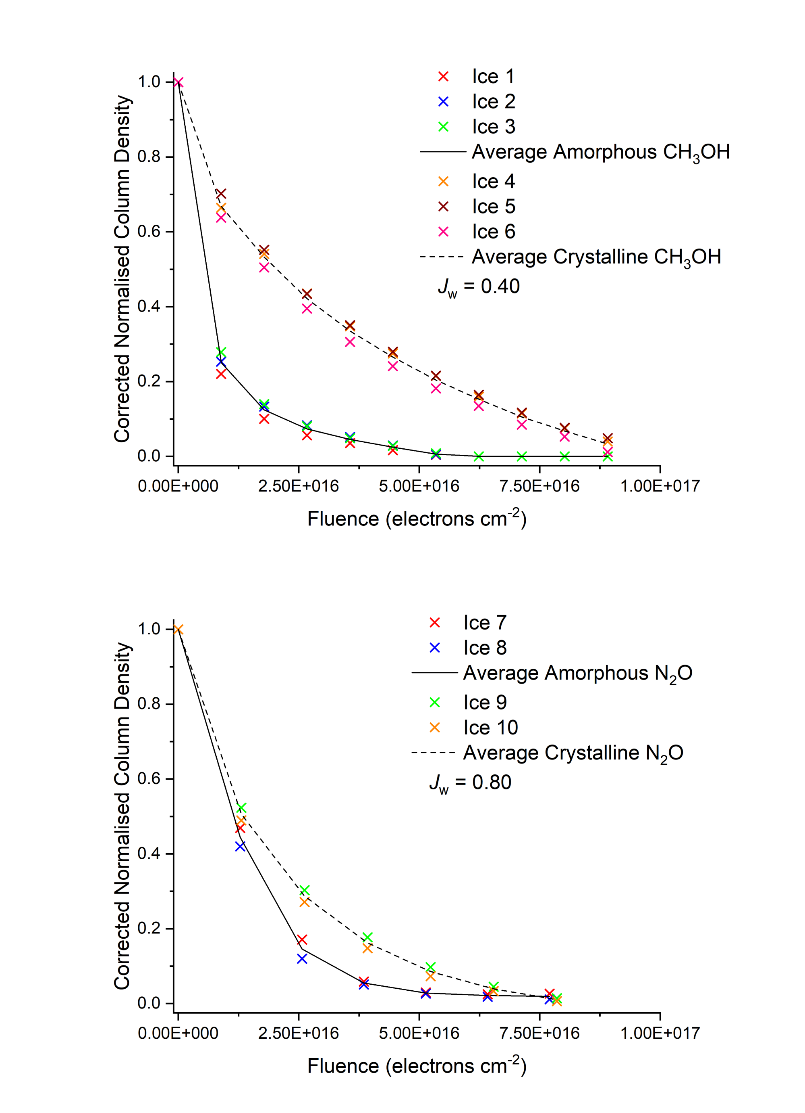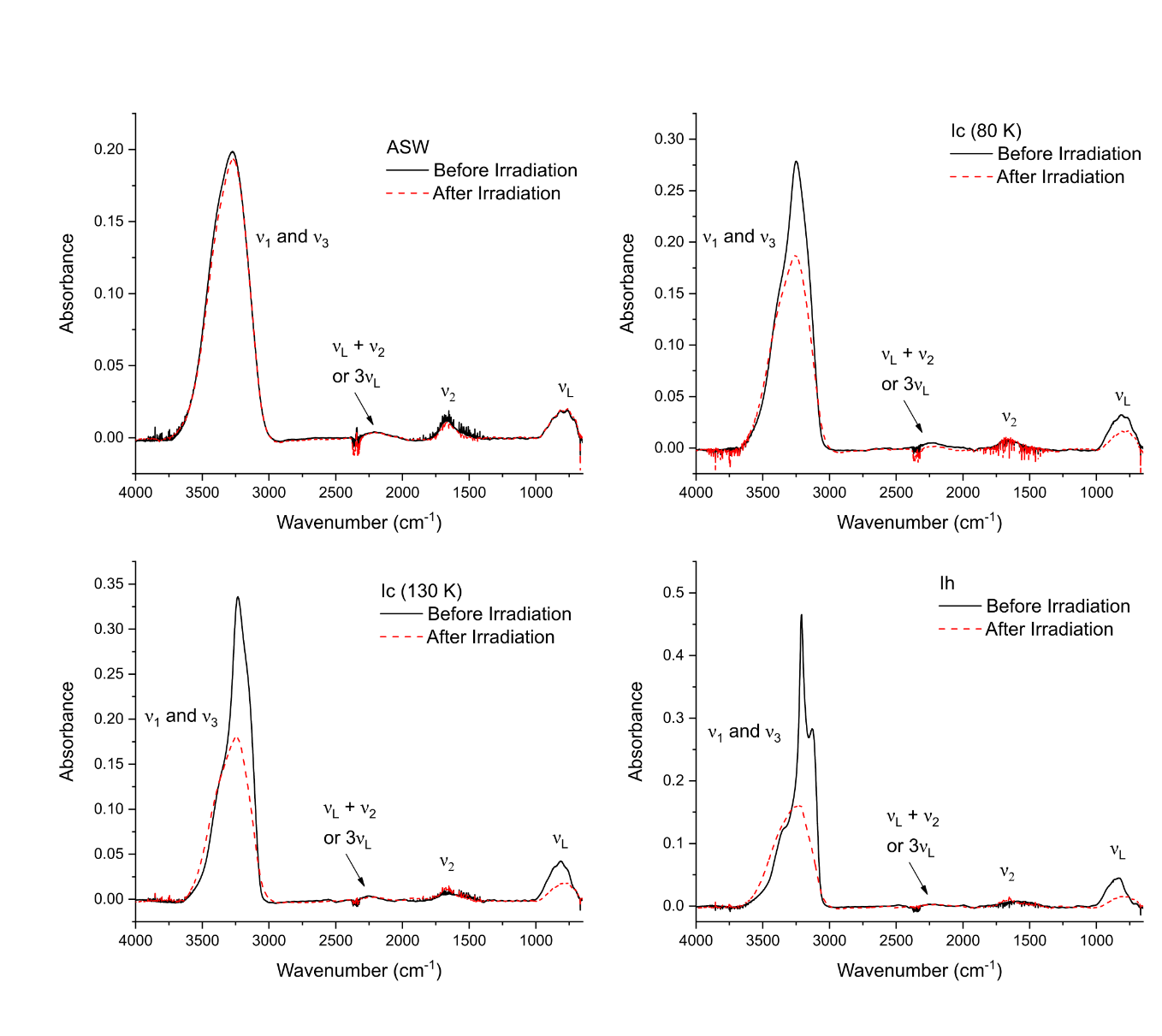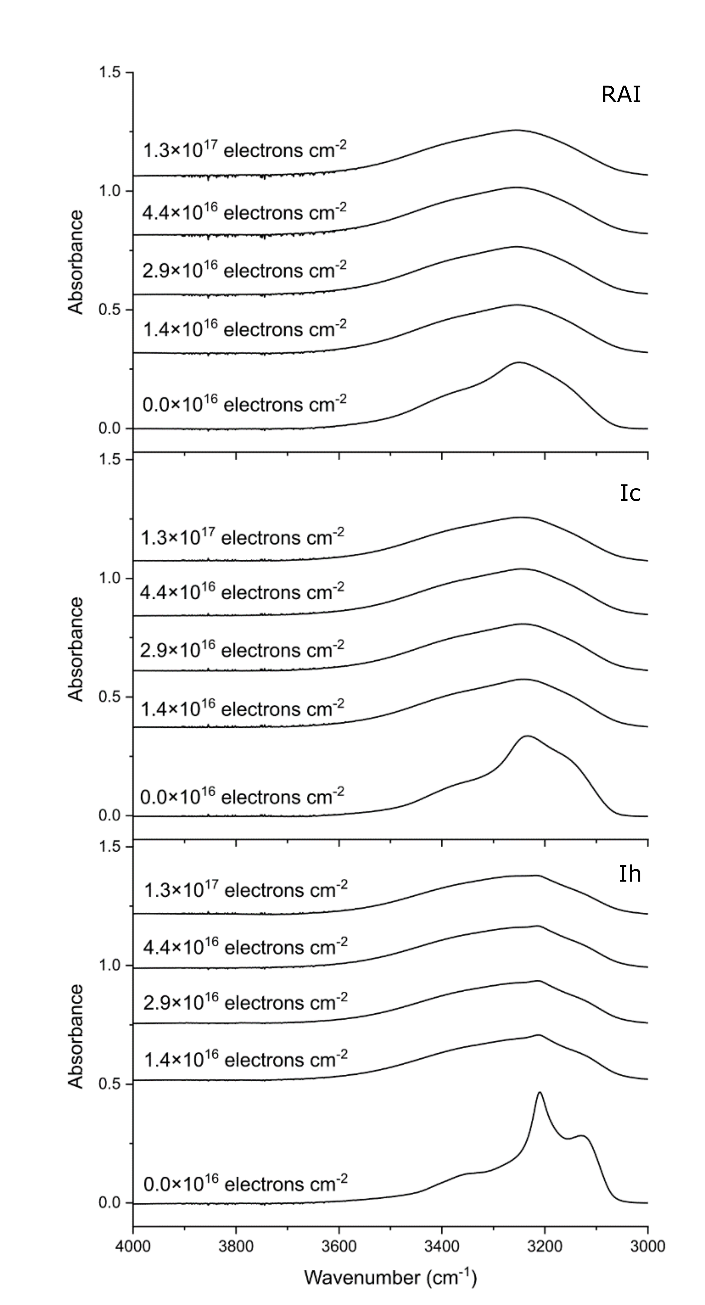The Effect of the Solid Phase Adopted by Astrophysical Ices on their Radiation Chemistry and Physics: Implications for the Synthesis of Prebiotic Molecules
- 1Centre for Astrophysics and Planetary Science, School of Physical Sciences, University of Kent, Canterbury CT2 7NH, United Kingdom
- 2Institute for Nuclear Research (Atomki), Debrecen H-4026, Hungary
- 3School of Electronic Engineering and Computer Science, Queen Mary University of London, London E1 4NS, United Kingdom
- 4Astronomical Institute, Slovak Academy of Sciences, Tatranská Lomnica, SK-059 60, Slovakia
- 5Department of Physics, Faculty of Mechanical Engineering and Informatics, University of Miskolc, Miskolc H-3515, Hungary
- 6Department of Physics and Astronomy, School of Mathematics and Physics, Queen's University Belfast, Belfast BT7 1NN, United Kingdom
Laboratory studies of the radiation chemistry occurring in astrophysical ices have sought to better understand the dependence of this chemistry on a number of experimental parameters, such as the temperature of the ice or the energy of the incident radiation. One experimental parameter which has received significantly less attention from the research community is that of the phase of the solid ice under investigation. Our research group based at the Institute for Nuclear Research (Atomki) in Debrecen, Hungary has therefore made use of the custom-built Ice Chamber for Astrophysics-Astrochemistry (ICA) [1,2] to conduct experiments aimed at providing a better understanding of the role of the solid phase of an ice in determining the outcome of its radiation (astro)chemistry.
We have performed a series of systematic and comparative 2 keV electron irradiations of the amorphous and crystalline phases of various pure astrophysical ice analogues, including N2O, CH3OH, and H2O, at 20 K [3,4]. The radiation-induced decay of these ices and the concomitant formation of products were monitored in situ using FT-IR spectroscopy. A direct comparison between the irradiated amorphous and crystalline CH3OH ices revealed a significantly more rapid decay of the former compared to the latter. Interestingly, a significantly smaller difference was observed when comparing the decay rates of the amorphous and crystalline N2O ices (Figure 1).
The extent of the similarity between the radiolytic decay curves of the amorphous and crystalline phases of these ices has been quantified by applying the weighted Jaccard coefficient, Jw (also sometimes referred to as the Tanimoto coefficient). This coefficient measures the similarity between two real, non-zero functions and varies between 0-1, with the 0 indicating no statistical similarity whatsoever and the 1 indicating identical functions. In the case of the radiolytic decay curves for the amorphous and crystalline CH3OH ices, Jw = 0.40, while in the case of the investigated N2O ices this was much higher at Jw = 0.80.

Figure 1: Electron-induced decay of CH3OH (above) and N2O (below) ice phases with increasing 2 keV electron fluence. Reproduced from Mifsud et al. (2022) with permission of the Royal Society of Chemistry [3].
These results have been interpreted in terms of the strength and extent of the intermolecular forces of attraction present in each molecular ice. The strong and extensive hydrogen-bonding network that exists in the crystalline CH3OH – but not in the amorphous phase – is thought to add a significant stabilizing effect to this phase which makes it more resistant to radiation-induced decay. On the other hand, although the alignment of the molecular dipole of N2O is expected to be more extensive in the crystalline phase, its weak attractive potential does not significantly stabilize the crystalline phase against radiation-induced decay compared to the amorphous phase as in the case of CH3OH.
Experiments were also performed on various phases of H2O ices using 2 keV electrons. Irradiated amorphous solid water (ASW), restrained amorphous ice (RAI), cubic crystalline ice (Ic), and cubic hexagonal ice (Ih) were found to demonstrate different responses upon the onset of electron irradiation (Figure 2). For example, the compaction of ASW ice was noted to occur fairly quickly. The ordered phases, on the other hand, all underwent amorphization as a result of their irradiation by energetic electrons. Interestingly, the amorphization of Ih was noted to require a higher electron fluence compared to those of RAI and Ic (Figure 3). This is perhaps not unexpected, as these latter phases are only meta-stable with respect to Ih.

Figure 2: FTIR spectra of ASW, RAI, Ic, and Ih ice phases before and after irradiation using a fluence of 1.3×1017 electrons cm–2. Reproduced from Mifsud et al. (2022) with kind permission of The European Physical Journal [4].
Large variations in the appearance and shape of the mid-infrared absorption bands between the crystalline and amorphous H2O ices made the use of the weighted Jaccard coefficient difficult and inappropriate. As such, the difference in the radiolytic decay rates of these ices was gauged indirectly by measuring the yield of H2O2 observed after electron irradiation of each phase. The ASW ice was found to be the most chemically productive in this way, with 0.32% of the H2O being converted to H2O2. On moving to more ordered phases, however, the H2O2 yield was found to progressively decline, with 0.21, 0.16, and 0.14% of the H2O being converted to H2O2 as a result of the irradiation of the RAI, Ic, and Ih phases, respectively.
Our results have important implications for radiative astrochemistry of interstellar and outer Solar System ices, as it is clear that the radiolytic decay and, by extension, the potential chemical productivities of these ices are greater when they are in the amorphous state rather than the crystalline phase. Given that most astrophysical ices undergo cycles of thermally induced crystallization and space radiation induced amorphization, our results suggest that the formation of new molecules (including those complex molecules of relevance to biology and the emergence of life) as a result of the processing of these ices by galactic cosmic rays, the solar wind, or giant planetary magnetospheric plasmas is most productive in those astrophysical regions where the amorphization process is more efficient. This is not an unreasonable conclusion, particularly in light of the recent spate of discoveries of complex organic molecules in the pre-stellar cloud TMC-1 [e.g., 5,6].

Figure 3: Structured H2O stretching modes were observed to broaden as a result of electron-induced amorphization of the ices; which is suggested to be slower in the Ih phase.
The authors all gratefully acknowledge funding from the Europlanet 2024 RI which has been funded by the European Union Horizon 2020 Research Innovation Programme under grant agreement No. 871149.
References:
[1] P. Herczku, et al. Rev. Sci. Instrum. 92, 084501 (2021)
[2] D.V. Mifsud, et al. Eur. Phys. J. D. 75, 182 (2021)
[3] D.V. Mifsud, et al. Phys. Chem. Chem. Phys. 24, 10974 (2022)
[4] D.V. Mifsud, et al. Eur. Phys. J. D. 76, 87 (2022)
[5] B.A. McGuire et al. Science 371, 1265 (2021)
[6] K.L.K. Lee et al. Astrophys. J. Lett. 908, L11 (2021)
How to cite: Mifsud, D., Hailey, P., Herczku, P., Juhász, Z., Kovács, S., Sulik, B., Kumar Kushwaha, R., Rácz, R., Biri, S., Ioppolo, S., Kaňuchová, Z., Paripás, B., McCullough, R., and Mason, N.: The Effect of the Solid Phase Adopted by Astrophysical Ices on their Radiation Chemistry and Physics: Implications for the Synthesis of Prebiotic Molecules, Europlanet Science Congress 2022, Granada, Spain, 18–23 Sep 2022, EPSC2022-832, https://doi.org/10.5194/epsc2022-832, 2022.

